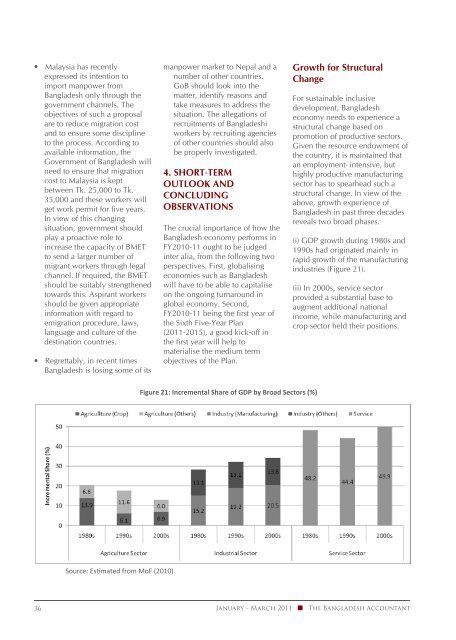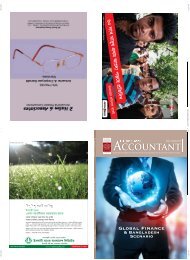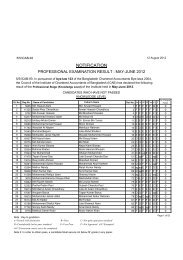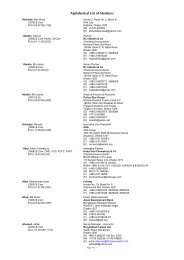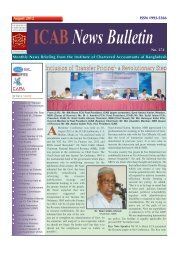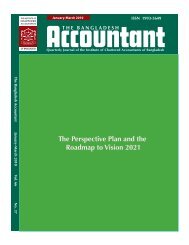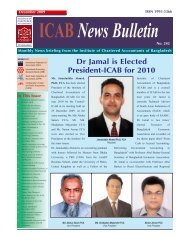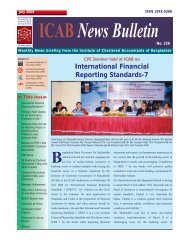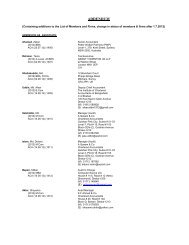Forma # 1.ai - ICAB
Forma # 1.ai - ICAB
Forma # 1.ai - ICAB
You also want an ePaper? Increase the reach of your titles
YUMPU automatically turns print PDFs into web optimized ePapers that Google loves.
• Malaysia has recently<br />
expressed its intention to<br />
import manpower from<br />
Bangladesh only through the<br />
government channels. The<br />
objectives of such a proposal<br />
are to reduce migration cost<br />
and to ensure some discipline<br />
to the process. According to<br />
available information, the<br />
Government of Bangladesh will<br />
need to ensure that migration<br />
cost to Malaysia is kept<br />
between Tk. 25,000 to Tk.<br />
35,000 and these workers will<br />
get work permit for five years.<br />
In view of this changing<br />
situation, government should<br />
play a proactive role to<br />
increase the capacity of BMET<br />
to send a larger number of<br />
migrant workers through legal<br />
channel. If required, the BMET<br />
should be suitably strengthened<br />
towards this. Aspirant workers<br />
should be given appropriate<br />
information with regard to<br />
emigration procedure, laws,<br />
language and culture of the<br />
destination countries.<br />
• Regrettably, in recent times<br />
Bangladesh is losing some of its<br />
manpower market to Nepal and a<br />
number of other countries.<br />
GoB should look into the<br />
matter, identify reasons and<br />
take measures to address the<br />
situation. The allegations of<br />
recruitments of Bangladeshi<br />
workers by recruiting agencies<br />
of other countries should also<br />
be properly investigated.<br />
4. SHORT‐TERM<br />
OUTLOOK AND<br />
CONCLUDING<br />
OBSERVATIONS<br />
The crucial importance of how the<br />
Bangladesh economy performs in<br />
FY2010‐11 ought to be judged<br />
inter alia, from the following two<br />
perspectives. First, globalising<br />
economies such as Bangladesh<br />
will have to be able to capitalise<br />
on the ongoing turnaround in<br />
global economy. Second,<br />
FY2010‐11 being the first year of<br />
the Sixth Five‐Year Plan<br />
(2011‐2015), a good kick‐off in<br />
the first year will help to<br />
materialise the medium term<br />
objectives of the Plan.<br />
Growth for Structural<br />
Change<br />
For sustainable inclusive<br />
development, Bangladesh<br />
economy needs to experience a<br />
structural change based on<br />
promotion of productive sectors.<br />
Given the resource endowment of<br />
the country, it is maintained that<br />
an employment‐ intensive, but<br />
highly productive manufacturing<br />
sector has to spearhead such a<br />
structural change. In view of the<br />
above, growth experience of<br />
Bangladesh in past three decades<br />
reveals two broad phases.<br />
(i) GDP growth during 1980s and<br />
1990s had originated mainly in<br />
rapid growth of the manufacturing<br />
industries (Figure 21).<br />
(ii) In 2000s, service sector<br />
provided a substantial base to<br />
augment additional national<br />
income, while manufacturing and<br />
crop sector held their positions.<br />
Figure 21: Incremental Share of GDP by Broad Sectors (%)<br />
Source: Esmated from MoF (2010).<br />
36<br />
January - March 2011<br />
The Bangladesh Accountant


